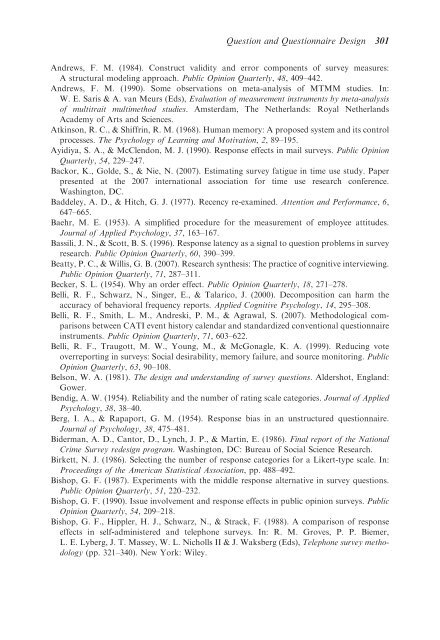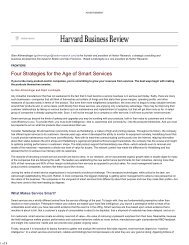Question and Questionnaire Design - Stanford University
Question and Questionnaire Design - Stanford University
Question and Questionnaire Design - Stanford University
Create successful ePaper yourself
Turn your PDF publications into a flip-book with our unique Google optimized e-Paper software.
<strong>Question</strong> <strong>and</strong> <strong>Question</strong>naire <strong>Design</strong> 301Andrews, F. M. (1984). Construct validity <strong>and</strong> error components of survey measures:A structural modeling approach. Public Opinion Quarterly, 48, 409–442.Andrews, F. M. (1990). Some observations on meta-analysis of MTMM studies. In:W. E. Saris & A. van Meurs (Eds), Evaluation of measurement instruments by meta-analysisof multitrait multimethod studies. Amsterdam, The Netherl<strong>and</strong>s: Royal Netherl<strong>and</strong>sAcademy of Arts <strong>and</strong> Sciences.Atkinson, R. C., & Shiffrin, R. M. (1968). Human memory: A proposed system <strong>and</strong> its controlprocesses. The Psychology of Learning <strong>and</strong> Motivation, 2, 89–195.Ayidiya, S. A., & McClendon, M. J. (1990). Response effects in mail surveys. Public OpinionQuarterly, 54, 229–247.Backor, K., Golde, S., & Nie, N. (2007). Estimating survey fatigue in time use study. Paperpresented at the 2007 international association for time use research conference.Washington, DC.Baddeley, A. D., & Hitch, G. J. (1977). Recency re-examined. Attention <strong>and</strong> Performance, 6,647–665.Baehr, M. E. (1953). A simplified procedure for the measurement of employee attitudes.Journal of Applied Psychology, 37, 163–167.Bassili, J. N., & Scott, B. S. (1996). Response latency as a signal to question problems in surveyresearch. Public Opinion Quarterly, 60, 390–399.Beatty, P. C., & Willis, G. B. (2007). Research synthesis: The practice of cognitive interviewing.Public Opinion Quarterly, 71, 287–311.Becker, S. L. (1954). Why an order effect. Public Opinion Quarterly, 18, 271–278.Belli, R. F., Schwarz, N., Singer, E., & Talarico, J. (2000). Decomposition can harm theaccuracy of behavioral frequency reports. Applied Cognitive Psychology, 14, 295–308.Belli, R. F., Smith, L. M., Andreski, P. M., & Agrawal, S. (2007). Methodological comparisonsbetween CATI event history calendar <strong>and</strong> st<strong>and</strong>ardized conventional questionnaireinstruments. Public Opinion Quarterly, 71, 603–622.Belli, R. F., Traugott, M. W., Young, M., & McGonagle, K. A. (1999). Reducing voteoverreporting in surveys: Social desirability, memory failure, <strong>and</strong> source monitoring. PublicOpinion Quarterly, 63, 90–108.Belson, W. A. (1981). The design <strong>and</strong> underst<strong>and</strong>ing of survey questions. Aldershot, Engl<strong>and</strong>:Gower.Bendig, A. W. (1954). Reliability <strong>and</strong> the number of rating scale categories. Journal of AppliedPsychology, 38, 38–40.Berg, I. A., & Rapaport, G. M. (1954). Response bias in an unstructured questionnaire.Journal of Psychology, 38, 475–481.Biderman, A. D., Cantor, D., Lynch, J. P., & Martin, E. (1986). Final report of the NationalCrime Survey redesign program. Washington, DC: Bureau of Social Science Research.Birkett, N. J. (1986). Selecting the number of response categories for a Likert-type scale. In:Proceedings of the American Statistical Association, pp. 488–492.Bishop, G. F. (1987). Experiments with the middle response alternative in survey questions.Public Opinion Quarterly, 51, 220–232.Bishop, G. F. (1990). Issue involvement <strong>and</strong> response effects in public opinion surveys. PublicOpinion Quarterly, 54, 209–218.Bishop, G. F., Hippler, H. J., Schwarz, N., & Strack, F. (1988). A comparison of responseeffects in self-administered <strong>and</strong> telephone surveys. In: R. M. Groves, P. P. Biemer,L. E. Lyberg, J. T. Massey, W. L. Nicholls II & J. Waksberg (Eds), Telephone survey methodology(pp. 321–340). New York: Wiley.
















